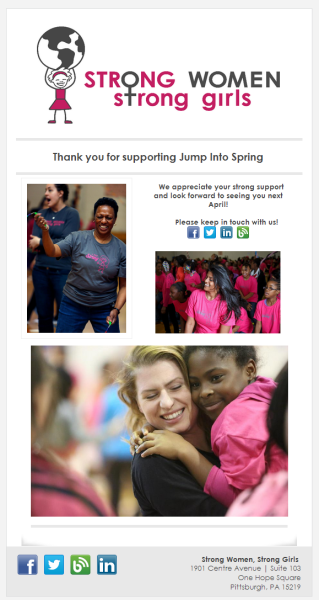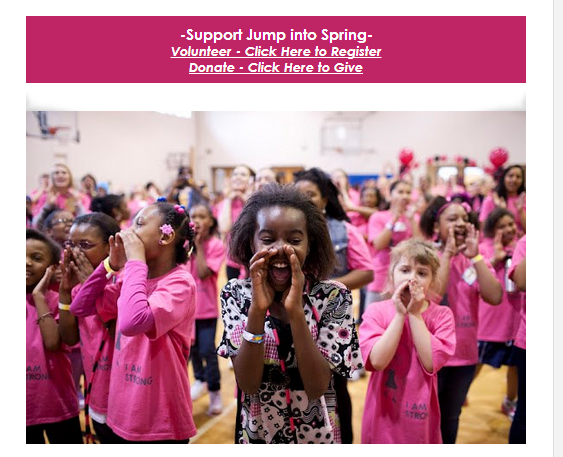Here’s something we could all stand to be reminded of from time to time: asking for help is a sign of strength, not weakness.
But even if you know that’s true, it’s still easy to feel intimidated when you’re making a BIG ask.
Boston-based nonprofit, Strong Women, Strong Girls (SWSG), is a mentoring organization that positively impacts thousands of young girls and women across the nation.
All with just 12 full-time staff members.
Their three tier mentoring program focuses on using relationships, skills, and role models to empower girls and women to succeed as leaders of their generation. With current locations spanning Boston, Pittsburgh, and South Florida, the small team relies on support from their community to keep the organization going strong.
Using SWSG as our model, let’s take a look at the steps you need to take for your ask to come across loud and clear.
1. Take the plunge
If you want to get your contacts to donate time, money or anything else, you’re going to have to gain their trust and confidence first. A great way to do that is with a professional and attention grabbing email newsletter.
If you’re new to the email marketing scene, creating an email newsletter might seem a little daunting at first.
That’s how it seemed to FAO Schwarz Fellow, Kayla Peck, when she joined the SWSG team 9 months ago. “When I first started, I didn’t have any communication experience so I was really coming from a novice perspective,” Kayla recalls. “Luckily, Constant Contact is really user friendly and it didn’t take me long to get a handle on it.”
Even if you’re interested in giving email marketing a try, you might still feel nervous about the time commitment.
“The biggest benefit of email marketing, from a staff perspective, is efficiency. I have a template made so it’s easy to pull together an email quickly,” Kayla explains. “I think the rest of my staff thinks it takes me a lot longer to create an email than it actually does!”
Ok, ready to jump in? Now you have to learn how to make your emails effective enough to inspire action.
2. Show off your strengths
The age-old writing mantra, “Show, don’t tell” can be applied to emails as well.
Because a lot of your contacts will be rifling through their emails quickly (and often on a small screen), it’s important that your emails are visually clear and easy to scan.
“We try to tell a story through pictures in our emails,” Kayla says. “Our emails are short, sweet, and structured so readers can get to the point quickly.”
Take a look at the email below. Using only three sentences of text, the email is effective in communicating a message to its recipient.

3. Be proud of your organization
The biggest mistake organizations make when asking for donations is shying away from what they’re asking for.
“Every spring we hold a large event called Jump into Spring. This is our largest event of the year, so we need as much help as we can get,” Kayla explains.
“With our emails, we give them multiple opportunities to get involved. It’s important for our contacts to understand that they are a crucial part of our community and their support, whatever they are able to give, is what keeps us going.”

4. Make your donations page specific
In addition to making your ask prominent in your emails, it’s also a great idea to get specific in expressing why donations are important to your organization.
Let’s take a look at the explanation SWSG offers on their donations page:
Your donation goes a long way: $250 supports field trip supplies for a girl for a year, $100 supports a college mentor’s training, $50 supports a personalized coaching session for a team of 3-4 SWSG mentors, and $25 provides curriculum binders to a team of SWSG mentors. Please also consider providing long-term support through a recurring monthly gift!
These details can be a great motivator for someone on the fence about making a donation.
“We make sure to align all our language with our organization in mind,” explains Kayla. “We want anyone reading our information to feel close to our mission. We especially want them to realize and understand that they have an active and participatory role in our community.”
Ready to bring it all together? Take the plunge and follow SWSG’s lead with an ask that’s strong, proud, loud, and clear.
What’s your experience with “big asks?” What’s worked, what hasn’t worked? Tell us about it below.
Two-thirds of small businesses are on board, proving that mobile marketing is no longer the sole domain of major brands like Subway, Google, and Target. Given the growing interest in mobile marketing among small businesses, it seems worthwhile to take a deeper look at the survey results.
So, how exactly are small businesses using mobile technology?
More than 70 percent of small businesses are using mobile for social media marketing and email marketing — think Facebook updates and email newsletters that can be viewed on smartphones or tablets.
Forty-four percent are conducting mobile advertising through social platforms.
When asked what types of mobile/social advertising they use, 97 percent of respondents said they use social media platforms like YouTube, Pinterest, Twitter, Facebook, and Instagram. Location-based promotions (Foursquare check-in, etc.) came in a distant second at 17 percent and text messages came in third at 15 percent.
Another interesting survey tidbit — small business owners are big Apple fans. iPhone users trump Android users 66 percent to 39 percent. Sounds like Apple’s carved out a good small business niche given that among the general population, Android subscribers account for more than half of all subscribers while iOS subscribers account for just 38 percent.
By now you’ve probably heard the ubiquitous stat that claims there are more mobile phones than toothbrushes on the planet, so it’s great to see small businesses taking advantage of mobile marketing. And why not? It’s a fast and direct way to reach customers and mobile advertising can be very cost-effective. There’s no denying our mobile-optimized world and it’s not going away, especially when you consider some analysts are predicting that mobile searches will surpass desktop searches this year.
Of course, there’s always the flip side of the coin and that leads us to the 34 percent of small businesses who’ve not yet boarded the mobile train.
Why not? A lack of customer demand?
Fifty-six percent say their customers haven’t expressed a demand for mobile communications and 47 percent say their customers haven’t expressed a demand for mobile payment solutions. More than a few respondents even said things like, “I have no idea how this stuff works.” The problem with this wait-and-see approach is that you may miss some prime marketing opportunities. Not convinced? Consider the fact that 42% of emails are opened on mobile devices and 1 in 5 internet users don’t use a computer. Mobile is a way of life and smart small business marketers need to climb aboard before this train leaves the station.
And now, a question for you: Are you using mobile to market your business and if so, how?
